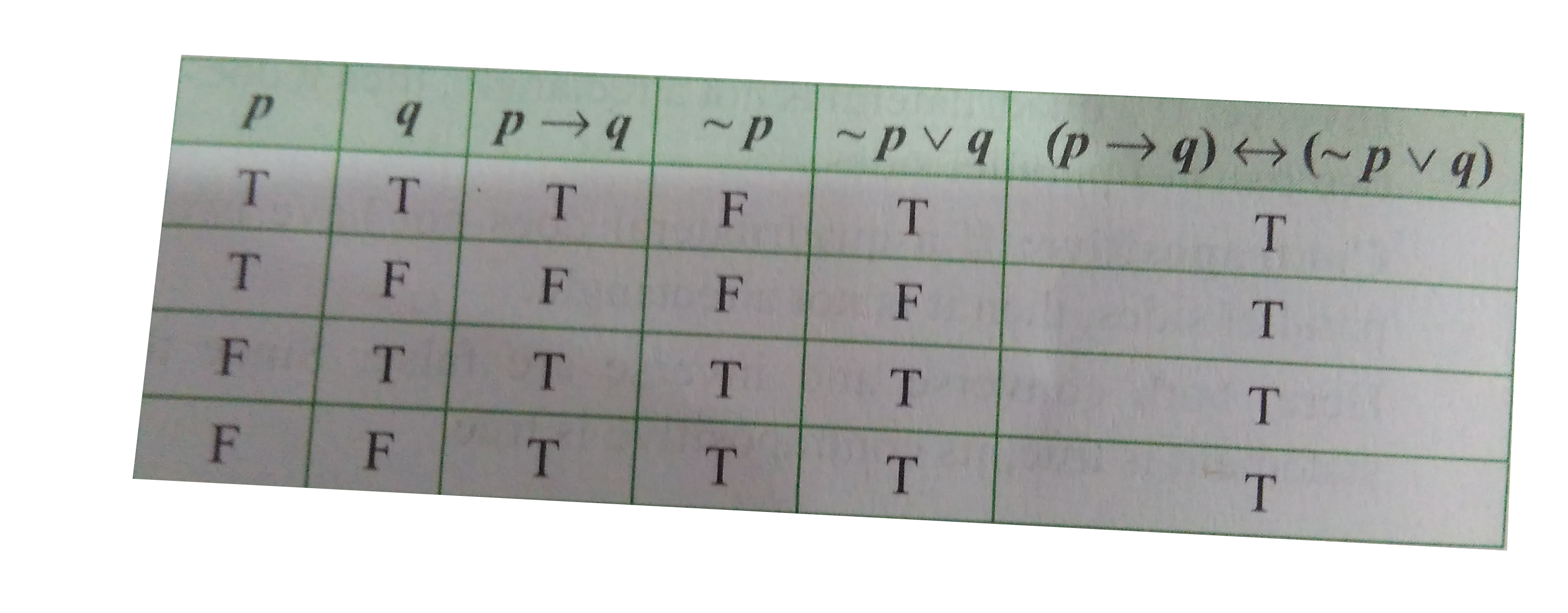In the truth table for the statements (p→q)↔(~p∨q), the last column has the truth value in the following orderSolution in Bengali
(a) TTTT
(b) FTFT
(c) TTFF
(d) FFFF
The correct Answer is:A
Topper's Solved these Questions
- BOOK - CENGAGE PUBLICATIONCHAPTER - MATHMETICAL REASONINGEXERCISE - Archives10videos
MATHMETICAL REASONING
- BOOK - CENGAGE PUBLICATIONCHAPTER - MATHMETICAL REASONINGEXERCISE - concept application13videos
MATHMETICAL REASONING
- BOOK - CENGAGE PUBLICATIONCHAPTER - LOGARITHM AND ITS PROPERTIESEXERCISE - JEE ADVANCED1videos
LOGARITHM AND ITS PROPERTIES
- BOOK - CENGAGE PUBLICATIONCHAPTER - MATRICESEXERCISE - All Questions509videos
MATRICES
Similar Questions
Statements -1 : ~(p↔~q) is equivalent to p↔q
Statement-2: ~(p↔~q) is a tautology.02:38View SolutionWrite down the truth table for the compound statements :
(~p∨q)∧(~p∧~q)02:41View SolutionLet (x0,y0) be the solution of the following equations: (2x)1n2=(3y)1n3 31nx=21ny The x0 is 16 (b) 13 (c) 12 (d) 6
03:41View SolutionIn which of the following type of matrix inverse does not exist always? a. idempotent b. orthogonal c. involuntary d. none of these
05:18View SolutionIf p→(~p∨q) is false, the truth values of p and q are , respectively
02:42View SolutionIn the truth table for the statements (p→q)↔(~p∨q), the last column has the truth value in the following order
01:40View SolutionIn the truth table for the statement (~p⇒~q)∧(~q⇒~p), the last column has the truth value in the following order
01:59View SolutionPrepare truth tables for the following statements :
(1) (p∧q)→(~P) (2) ~(~p∧~q)∨q (3) p→[~(q∧r)]02:31View Solutionमिश्रित कथन (~p)∨q के लिए सत्यमान सारणी बनाये
04:58View SolutionIn the last column of the truth table for ~(p∨~q) the number of final outcomes of the truth value 'F' are
01:36View SolutionIf p and q have truth value 'F', then the truth values of (~p∨q)↔~(p∧q) and p↔(p→~q) are respectively
02:34View SolutionThe truth table of p⇔q is
02:43View Solutionयदि p⇒(~p V q) असत्य है, तब p और q के सत्यता मान क्रमश: हैं
02:12View SolutionIf p→(~p∨q) is false, the truth values of p and q are , respectively
02:37View SolutionIn the truth table for the statements (p→q)↔(~p∨q), the last column has the truth value in the following order
02:14View Solution


